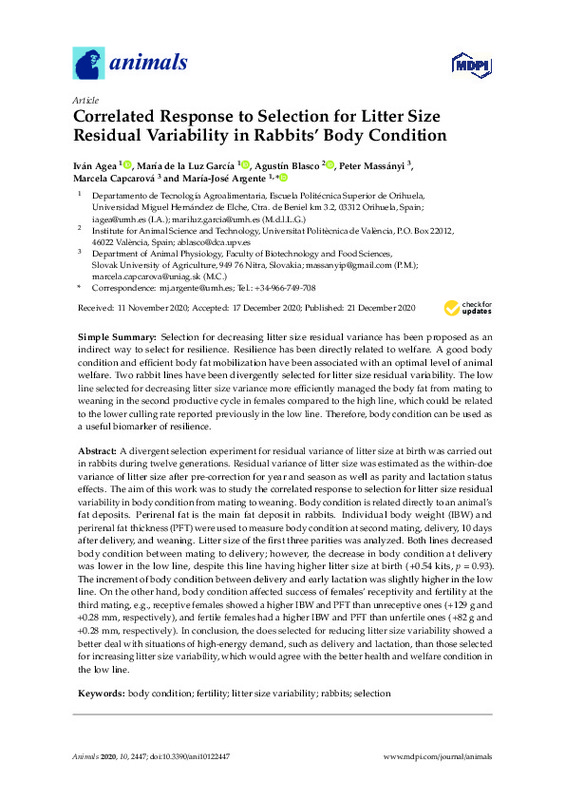Colditz, I. G., & Hine, B. C. (2016). Resilience in farm animals: biology, management, breeding and implications for animal welfare. Animal Production Science, 56(12), 1961. doi:10.1071/an15297
Berghof, T. V. L., Poppe, M., & Mulder, H. A. (2019). Opportunities to Improve Resilience in Animal Breeding Programs. Frontiers in Genetics, 9. doi:10.3389/fgene.2018.00692
Schröder, U. J., & Staufenbiel, R. (2006). Invited Review: Methods to Determine Body Fat Reserves in the Dairy Cow with Special Regard to Ultrasonographic Measurement of Backfat Thickness. Journal of Dairy Science, 89(1), 1-14. doi:10.3168/jds.s0022-0302(06)72064-1
[+]
Colditz, I. G., & Hine, B. C. (2016). Resilience in farm animals: biology, management, breeding and implications for animal welfare. Animal Production Science, 56(12), 1961. doi:10.1071/an15297
Berghof, T. V. L., Poppe, M., & Mulder, H. A. (2019). Opportunities to Improve Resilience in Animal Breeding Programs. Frontiers in Genetics, 9. doi:10.3389/fgene.2018.00692
Schröder, U. J., & Staufenbiel, R. (2006). Invited Review: Methods to Determine Body Fat Reserves in the Dairy Cow with Special Regard to Ultrasonographic Measurement of Backfat Thickness. Journal of Dairy Science, 89(1), 1-14. doi:10.3168/jds.s0022-0302(06)72064-1
Maes, D. G. D., Janssens, G. P. J., Delputte, P., Lammertyn, A., & de Kruif, A. (2004). Back fat measurements in sows from three commercial pig herds: relationship with reproductive efficiency and correlation with visual body condition scores. Livestock Production Science, 91(1-2), 57-67. doi:10.1016/j.livprodsci.2004.06.015
Pascual, J. J., Castella, F., Cervera, C., Blas, E., & Fernández-Carmona, J. (2000). The use of ultrasound measurement of perirenal fat thickness to estimate changes in body condition of young female rabbits. Animal Science, 70(3), 435-442. doi:10.1017/s135772980005178x
Barletta, R. V., Maturana Filho, M., Carvalho, P. D., Del Valle, T. A., Netto, A. S., Rennó, F. P., … Wiltbank, M. C. (2017). Association of changes among body condition score during the transition period with NEFA and BHBA concentrations, milk production, fertility, and health of Holstein cows. Theriogenology, 104, 30-36. doi:10.1016/j.theriogenology.2017.07.030
Van Staaveren, N., Doyle, B., Manzanilla, E. G., Calderón Díaz, J. A., Hanlon, A., & Boyle, L. A. (2017). Validation of carcass lesions as indicators for on-farm health and welfare of pigs. Journal of Animal Science, 95(4), 1528. doi:10.2527/jas2016.1180
Sánchez, J. P., de la Fuente, L. F., & Rosell, J. M. (2012). Health and body condition of lactating females on rabbit farms1. Journal of Animal Science, 90(7), 2353-2361. doi:10.2527/jas.2011-4065
Mulder, H. A., & Rashidi, H. (2017). Selection on resilience improves disease resistance and tolerance to infections. Journal of Animal Science, 95(8), 3346. doi:10.2527/jas2017.1479
Argente, M. J., García, M. L., Zbyňovská, K., Petruška, P., Capcarová, M., & Blasco, A. (2019). Correlated response to selection for litter size environmental variability in rabbits’ resilience. Animal, 13(10), 2348-2355. doi:10.1017/s1751731119000302
Blasco, A., Martínez-Álvaro, M., García, M.-L., Ibáñez-Escriche, N., & Argente, M.-J. (2017). Selection for environmental variance of litter size in rabbits. Genetics Selection Evolution, 49(1). doi:10.1186/s12711-017-0323-4
Beloumi, D., Blasco, A., Muelas, R., Santacreu, M. A., García, M. de la L., & Argente, M.-J. (2020). Inflammatory Correlated Response in Two Lines of Rabbit Selected Divergently for Litter Size Environmental Variability. Animals, 10(9), 1540. doi:10.3390/ani10091540
García, M. L., Blasco, A., García, M. E., & Argente, M. J. (2019). Correlated response in body condition and energy mobilisation in rabbits selected for litter size variability. Animal, 13(4), 784-789. doi:10.1017/s1751731118002203
Pascual J.J., Blanco J., Piquer O., & Quevedo F. Cervera C. (2010). Ultrasound measurements of perirenal fat thickness to estimate the body condition of reproducing rabbit does in different physiological states. World Rabbit Science, 12(1). doi:10.4995/wrs.2004.584
Iung, L. H. de S., Carvalheiro, R., Neves, H. H. de R., & Mulder, H. A. (2019). Genetics and genomics of uniformity and resilience in livestock and aquaculture species: A review. Journal of Animal Breeding and Genetics, 137(3), 263-280. doi:10.1111/jbg.12454
Agea, I., García, M.-L., Blasco, A., & Argente, M.-J. (2019). Litter Survival Differences between Divergently Selected Lines for Environmental Sensitivity in Rabbits. Animals, 9(9), 603. doi:10.3390/ani9090603
Fortun-Lamothe, L. (2006). Energy balance and reproductive performance in rabbit does. Animal Reproduction Science, 93(1-2), 1-15. doi:10.1016/j.anireprosci.2005.06.009
Feugier, A., & Fortun-Lamothe, L. (2006). Extensive reproductive rhythm and early weaning improve body condition and fertility of rabbit does. Animal Research, 55(5), 459-470. doi:10.1051/animres:2006025
Theilgaard, P., Baselga, M., Blas, E., Friggens, N. C., Cervera, C., & Pascual, J. J. (2009). Differences in productive robustness in rabbits selected for reproductive longevity or litter size. Animal, 3(5), 637-646. doi:10.1017/s1751731109003838
Theilgaard, P., Sánchez, J. P., Pascual, J. J., Friggens, N. C., & Baselga, M. (2006). Effect of body fatness and selection for prolificacy on survival of rabbit does assessed using a cryopreserved control population. Livestock Science, 103(1-2), 65-73. doi:10.1016/j.livsci.2006.01.007
Arias-Álvarez, M., García-García, R. M., Rebollar, P. G., Revuelta, L., Millán, P., & Lorenzo, P. L. (2009). Influence of metabolic status on oocyte quality and follicular characteristics at different postpartum periods in primiparous rabbit does. Theriogenology, 72(5), 612-623. doi:10.1016/j.theriogenology.2009.04.017
Castellini, C. (2007). Reproductive activity and welfare of rabbit does. Italian Journal of Animal Science, 6(sup1), 743-747. doi:10.4081/ijas.2007.1s.743
Castellini, C., Dal Bosco, A., Arias-Álvarez, M., Lorenzo, P. L., Cardinali, R., & Rebollar, P. G. (2010). The main factors affecting the reproductive performance of rabbit does: A review. Animal Reproduction Science, 122(3-4), 174-182. doi:10.1016/j.anireprosci.2010.10.003
Xiccato, G., Bernardini, M., Castellini, C., Dalle Zotte, A., Queaque, P. I., & Trocino, A. (1999). Effect of postweaning feeding on the performance and energy balance of female rabbits at different physiological states. Journal of Animal Science, 77(2), 416. doi:10.2527/1999.772416x
Cardinali, R., Dal Bosco, A., Bonanno, A., Di Grigoli, A., Rebollar, P. G., Lorenzo, P. L., & Castellini, C. (2008). Connection between body condition score, chemical characteristics of body and reproductive traits of rabbit does. Livestock Science, 116(1-3), 209-215. doi:10.1016/j.livsci.2007.10.004
Castellini, C., Dal Bosco, A., & Cardinali, R. (2006). Long term effect of post-weaning rhythm on the body fat and performance of rabbit doe. Reproduction Nutrition Development, 46(2), 195-204. doi:10.1051/rnd:2006009
[-]









